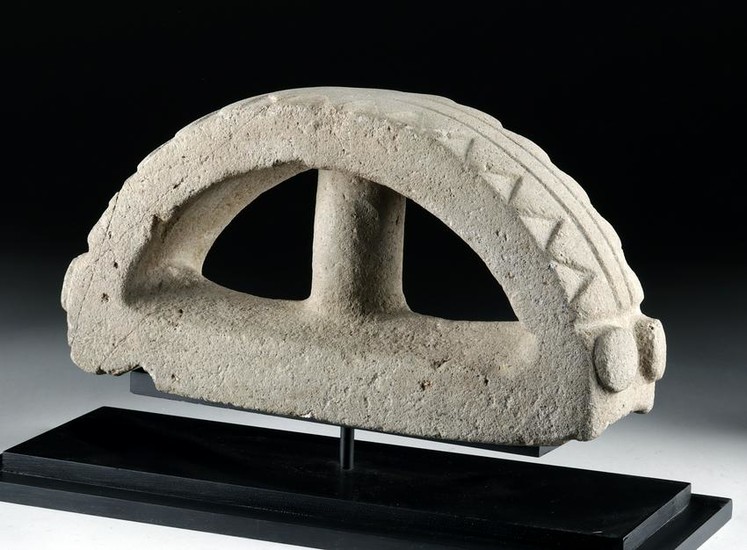Rare Olmec Stone Manopla - Caterpillar
Pre-Columbian, Mexico, Olmec culture, ca. 6th to 3rd century BCE. A manopla, a fascinating and rare stone artifact from the ball game, with a semicircle form, a thick columnar handle through its open center, and a relief image of a caterpillar carved onto the exterior of its curved face. It is made from pale grey volcanic stone. Manoplas were used to strike the heavy rubber ball in some versions of the ballgame, and they are found alongside yokes, hachas, and palmas. They originated in central Veracruz and then spread throughout Olmec territory, ultimately being used in the Yucatan and highland Guatemala. They are sometimes known as padlock stones. The caterpillar has two round, disc-like, bulging eyes and a symmetrical zigzag form along its back. Size: 13.5" W x 6.75" H (34.3 cm x 17.1 cm); 9.25" H (23.5 cm) on included custom stand.
The symbolism of the caterpillar is fascinating. Many Mesoamerican cultures believed that meteors became caterpillars when they struck the earth. The people of Teotihuacan and the Aztecs also associated caterpillars with the bundles in which they burned warriors' bodies, whose souls became butterflies in death. The Maya, meanwhile, seem to have used caterpillars to symbolize birth. The common theme is transformation, which must have been an important belief for the ancient person who commissioned this piece.
Provenance: private Hawaii, USA collection; ex-Peter Wray collection
All items legal to buy/sell under U.S. Statute covering cultural patrimony Code 2600, CHAPTER 14, and are guaranteed to be as described or your money back.
A Certificate of Authenticity will accompany all winning bids.
We ship worldwide to most countries and handle all shipping in-house for your convenience.
#145391
Condition Report: One side has been repaired from several large pieces. Repairs are well done and unobtrusive. The stone is weathered, with some small losses, mainly from the peripheries, and a slightly larger loss from the bottom edge. Otherwise nice preservation of form.
View it on
Estimate
Time, Location
Auction House
Pre-Columbian, Mexico, Olmec culture, ca. 6th to 3rd century BCE. A manopla, a fascinating and rare stone artifact from the ball game, with a semicircle form, a thick columnar handle through its open center, and a relief image of a caterpillar carved onto the exterior of its curved face. It is made from pale grey volcanic stone. Manoplas were used to strike the heavy rubber ball in some versions of the ballgame, and they are found alongside yokes, hachas, and palmas. They originated in central Veracruz and then spread throughout Olmec territory, ultimately being used in the Yucatan and highland Guatemala. They are sometimes known as padlock stones. The caterpillar has two round, disc-like, bulging eyes and a symmetrical zigzag form along its back. Size: 13.5" W x 6.75" H (34.3 cm x 17.1 cm); 9.25" H (23.5 cm) on included custom stand.
The symbolism of the caterpillar is fascinating. Many Mesoamerican cultures believed that meteors became caterpillars when they struck the earth. The people of Teotihuacan and the Aztecs also associated caterpillars with the bundles in which they burned warriors' bodies, whose souls became butterflies in death. The Maya, meanwhile, seem to have used caterpillars to symbolize birth. The common theme is transformation, which must have been an important belief for the ancient person who commissioned this piece.
Provenance: private Hawaii, USA collection; ex-Peter Wray collection
All items legal to buy/sell under U.S. Statute covering cultural patrimony Code 2600, CHAPTER 14, and are guaranteed to be as described or your money back.
A Certificate of Authenticity will accompany all winning bids.
We ship worldwide to most countries and handle all shipping in-house for your convenience.
#145391
Condition Report: One side has been repaired from several large pieces. Repairs are well done and unobtrusive. The stone is weathered, with some small losses, mainly from the peripheries, and a slightly larger loss from the bottom edge. Otherwise nice preservation of form.



